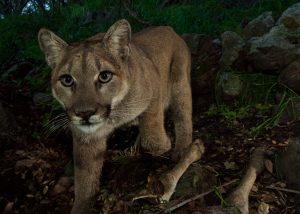
Mountain lion P-33 of Los Angeles County, the first mountain lion to have crossed the 101 Freeway and survived.
I have recently been researching a topic that has only grown in further prevalence since the 2016 election of Donald J. Trump: the interest in local wild cats and how they can be seen as vehicles for understanding the criminalization of migrants or indigenous persons as wild. Since before Trump was elected into office, Americans have been fueled by anxieties of the Southern Border and have criminalized those seen as different, yet little has been said in these conversations about how the southern border states have history in being spaces colonized by early settlers and migrants. Nevertheless, while California has shown itself as separate and distinct from Donald Trump’s imaginings of a white supremacist nation, a thread of this violence still exists in how our golden state views its mountain lions or species invading its white, domestic, and urban modern spaces.
A large draw for me in this work comes from Bénédicte Boisseron‘s latest book, Afro-Dog: Blackness and the Animal Question. Knowing how animals have been used to dehumanize and even cause violence against African-American and black subjects, Boisseron uses black feminist readings to argue that what we consider the animal is actually based on ideas of race. In looking at how race and animal violence is linked within current or recent debates, she writes:
The outpouring of concern for [Cecil the lion, an animal killed by a wealthy, white dental practitioner in 2015,], which some may perceive as surpassing interest in Dubose’s fate [Boisseron, here, referencing the murder of Samuel DuBose in 2015], is evocative of a plantation era where some masters, like Frederick Douglass’s, were said to care more about the well-being of their horses than that of their slaves. (32)
While some may find this work tangled in prescribing animality onto racialized subjects, Boisseron does not wish to conflate animality with racial or oppressed identities; instead, she argues one should use Crenshaw’s theory of intersectionality and “look at human-animal encounters through the prism of black and animal defiance [that] rejects the construction of blacks and animals as exclusively connected through their comparable state of subjection and humiliation, and instead focuses on interspecies alliances” (36). In doing so, we as feminist scholars can see how colonial violence still exists within our “progressive” state; if we then consider how species indigenous to California share a metonymic alliance and commonality to those seen as inhuman in Los Angeles, Texas, and elsewhere, we can find that with the rise of animal stories featuring mountain lions dying from intruding on human-centered spaces and neighborhoods, the rise of racial violence within the past several years stands in a closely intersectional development. The wild southern animal lurking in our mountains should not have come down and through here, some might say, for we would kill it for doing so.
We therefore arrive at her chapter “The Commensal Dog in a Creole Context,” in which she argues how “humanity is itself tainted with a racio-anthropocentric perspective that is part of a Western hegemonic and imperialistic design responsible for slavery and colonialism in the first place” (90-91). Whether or not one chooses to partake in the human-animal divide and race, which both Boisseron and I contend is difficult to take on, her conclusion even asking what gives scholars like us the right to ask these questions and speak for the animal that can never respond–we must agree that with the rise of both animal death and white supremacy is a realization that America has yet to move onward from its colonial and imperial history. As the elections grow closer to us with each passing day, we must thus consider how much our vote and decisions make in affecting the world around us.


Leave A Comment